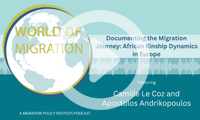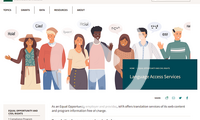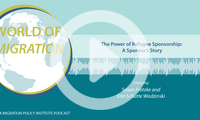Immigrant Integration
Recent Activity

Coordination and communication among key stakeholders in the resettlement network have never been more critical. This conversation focuses on how consultation supports capacity building and where it can, at times, fall short.

This webinar examines the challenges that refugees and other migrants face in—and place on—secondary cities, municipal capacity to respond to needs, the types of support required at national and other levels, and how development actors can better partner with secondary cities and local actors.

African migrants turn to the strength of kinship-based support systems in pursuit of stability as they settle in a European landscape that is sometimes made precarious by their legal status and shifting policies. This episode discusses use of the kinship networks, including to exchange or broker identity documents between migrants along the migration journey and at destination.

White House and Department of Health and Human Services officials join a leading language access advocate and MPI's Margie McHugh in a conversation exploring executive-branch efforts related to language access provision, upcoming actions, and opportunities to improve the provision of information and services in languages other than English in federal programs.

How is refugee resettlement evolving? As more countries turn to private or community sponsorship, MPI speaks with Erin Schutte Wadzinski, who leads one of the pioneering private sponsorship groups in Worthington, Minnesota, under the Welcome Corps initiative.
Pages
Recent Activity
The COVID-19 pandemic hit South American nations at a time when many were already contending with major migration challenges. Historic levels of intraregional migration and displacement, notably from Venezuela, collided with countries’ attempts to stop the spread of a new threat to public health. This report examines the region’s responses to the public-health crisis, and the immediate and lasting impacts on cross-border movement.















A Shrinking Number of DACA Participants Face Yet Another Adverse Court Ruling
Prolonged Ukrainian Displacement: An Uneasy Marriage of Reception, Integration, and Return Policies
Apprenticeship Programs Are a Promising Solution to Bring More Multilingual Workers into Early Childhood Field
Why the European Labor Market Integration of Displaced Ukrainians Is Defying Expectations
The Public-Charge Final Rule Is Far from the Last Word
Schools Should Engage Diverse Community Stakeholders to Promoting Equitable Allocation of Historic Funding to Reimagine Education
The Ukrainian Conflict Could Be a Tipping Point for Refugee Protection
Straight Path to Legal Permanent Residence for Afghan Evacuees Would Build on Strong U.S. Precedent
Opportunities Exist to Better Reach Dual Language Learner and Immigrant Families through Home Visiting Programs
Narrowing the Skills Gap: Equipping Immigrant-Origin Workers with Postsecondary Credentials
Pages